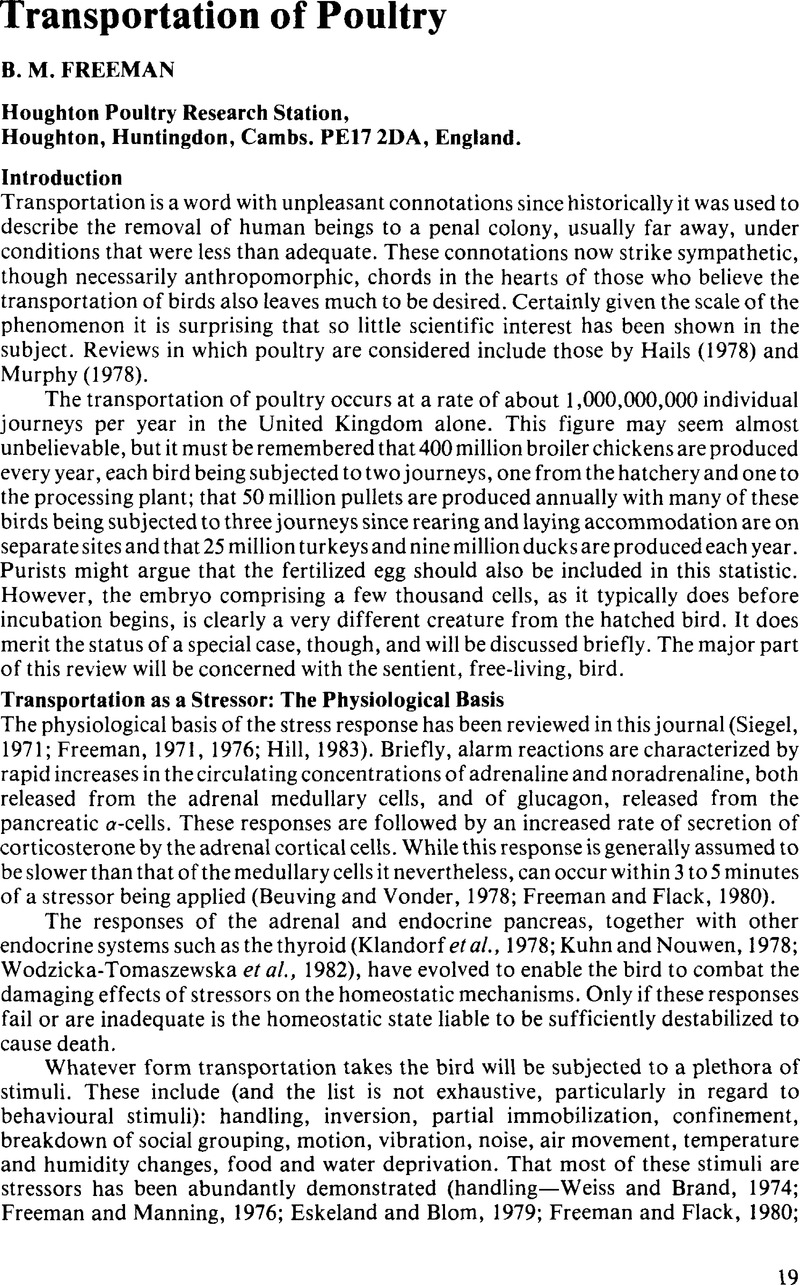Crossref Citations
This article has been cited by the following publications. This list is generated based on data provided by Crossref.
Cashman, P. J.
Nicol, Christine J.
and
Jones, R. B.
1989.
Effects of transportation on the tonic immobility fear reactions of broilers.
British Poultry Science,
Vol. 30,
Issue. 2,
p.
211.
Broom, D.M.
1990.
Effects of handling and transport on laying hens.
World's Poultry Science Journal,
Vol. 46,
Issue. 1,
p.
48.
Knowles, T.G.
and
Broom, D.M.
1990.
The handling and transport of broilers and spent hens.
Applied Animal Behaviour Science,
Vol. 28,
Issue. 1-2,
p.
75.
Nicol, C.J.
and
Scott, G.B.
1990.
Pre-slaughter handling and transport of broiler chickens.
Applied Animal Behaviour Science,
Vol. 28,
Issue. 1-2,
p.
57.
Nicol, C.J.
1992.
Effects of environmental enrichment and gentle handling on behaviour and fear responses of transported broilers.
Applied Animal Behaviour Science,
Vol. 33,
Issue. 4,
p.
367.
Kondaiah, N.
and
Panda, B.
1992.
Processing and utilization of spent hens.
World's Poultry Science Journal,
Vol. 48,
Issue. 3,
p.
255.
Scott, G.B.
and
Moran, P.
1993.
Fear levels in laying hens carried by hand and by mechanical conveyors.
Applied Animal Behaviour Science,
Vol. 36,
Issue. 4,
p.
337.
Moran, E.T.
and
Bilgili, S.F.
1995.
Influence of Broiler Livehaul on Carcass Quality and Further-Processing Yields.
Journal of Applied Poultry Research,
Vol. 4,
Issue. 1,
p.
13.
Parry, R. T.
1995.
Processing of Poultry.
p.
65.
Zulkifli, I.
Che Norma, M.T.
Chong, C.H.
and
Loh, T.C.
2000.
Heterophil to lymphocyte ratio and tonic immobility reactions to preslaughter handling in broiler chickens treated with ascorbic acid.
Poultry Science,
Vol. 79,
Issue. 3,
p.
402.
2004.
Opinion of the Scientific Panel on Animal Health and Welfare (AHAW) on a request from the Commission related to the welfare of animals during transport.
EFSA Journal,
Vol. 2,
Issue. 5,
Minka, N.S.
and
Ayo, J.O.
2008.
Haematology and behaviour of pullets transported by road and administered with ascorbic acid during the hot-dry season.
Research in Veterinary Science,
Vol. 85,
Issue. 2,
p.
389.
Mitchell, Malcolm A.
2009.
Chick Transport and Welfare.
Avian Biology Research,
Vol. 2,
Issue. 1-2,
p.
99.
Oviedo-Rondón, E.O.
Wineland, M.J.
Small, J.
Cutchin, H.
McElroy, A.
Barri, A.
and
Martin, S.
2009.
Effect of incubation temperatures and chick transportation conditions on bone development and leg health.
Journal of Applied Poultry Research,
Vol. 18,
Issue. 4,
p.
671.
Nielsen, B.L.
Dybkjær, L.
and
Herskin, M.S.
2011.
Road transport of farm animals: effects of journey duration on animal welfare.
Animal,
Vol. 5,
Issue. 3,
p.
415.
Minka, Salka Ndazo
and
Ayo, Joseph Olusegun
2012.
Hydration State of Goats Transported by Road for 12 Hours During the Hot-Dry Conditions and the Modulating Role of Ascorbic Acid.
Journal of Applied Animal Welfare Science,
Vol. 15,
Issue. 3,
p.
272.
Khosravinia, Heshmatollah
2015.
Physiological Responses of Newly Hatched Broiler Chicks to Increasing Journey Distance During Road Transportation.
Italian Journal of Animal Science,
Vol. 14,
Issue. 3,
p.
3964.
Huff, G. R.
Huff, W. E.
Rath, N. C.
Anthony, N. B.
and
Nestor, K. E.
2015.
Ascorbic Acid Differentially Affects Stress Response and Resistance to Colibacillosis in Turkeys from Genetic Lines Differing in Growth Rate.
Avian Diseases,
Vol. 59,
Issue. 2,
p.
323.
Minka, Ndazo S.
and
Ayo, Joseph O.
2016.
Effect of wet-cold weather transportation conditions on thermoregulation and the development of accidental hypothermia in pullets under tropical conditions.
International Journal of Biometeorology,
Vol. 60,
Issue. 3,
p.
373.
Cockram, Michael S.
Dulal, Ketan Jung
and
Plaizier, J.
2018.
Injury and mortality in broilers during handling and transport to slaughter.
Canadian Journal of Animal Science,
Vol. 98,
Issue. 3,
p.
416.



